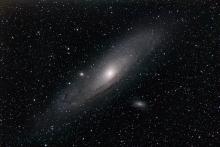This Hubble Space Telescope image shows a small section of M31, the Andromeda Galaxy. It is our closest large galactic neighbor, at a distance of about 2.5 million light-years. The galaxy's busy core, which is packed with stars, is at lower left. Lanes of dark dust and bright blue stars outline the galaxy's spiral arms, where new stars are born. This view spans about 60,000 light-years and shows roughly 100 million individual stars. [NASA/ESA/J. Dalcanton, B.F. Williams and L.C. Johnson (University of Washington)/PHAT team/R. Gendler]
You are here
Andromeda Galaxy
To take an amazing journey through time, look toward the east this evening. The bright orange star Aldebaran is low in the sky around 10 o’clock. It’s about 65 light-years away. That means the light we see from Aldebaran tonight actually left the star about 65 years ago.
The Pleiades star cluster stands above Aldebaran. It’s more than 400 light-years away, so we see it as it looked around the start of the 17th century.
But an object that stands high above Aldebaran and the Pleiades carries us much farther back in time: about two-and-a-half million years — a time when the ancestors of modern humans were developing the first stone tools.
M31, the Andromeda Galaxy, is the most-distant object that’s easily visible to the eye alone — two-and-a-half million light-years away. Under a fairly dark sky, it looks like a faint smudge of light.
M31 is similar to our own galaxy, the Milky Way. It’s a wide, flat disk that contains hundreds of billions of stars. There’s a big bulge of stars in the middle, with two beautiful spiral arms wrapped around it.
The entire disk may span more than 200,000 light-years. But the outer regions of the disk are quite faint, so the part that’s visible to the eye alone is about half that size. So we see the far side of the disk as it looked a hundred-thousand years farther in the past than the near side — a sort of time machine within a time machine for this giant city of stars.
More about M31 tomorrow.
Get Premium Audio
Listen to today's episode of StarDate on the web the same day it airs in high-quality streaming audio without any extra ads or announcements. Choose a $8 one-month pass, or listen every day for a year for just $30.







